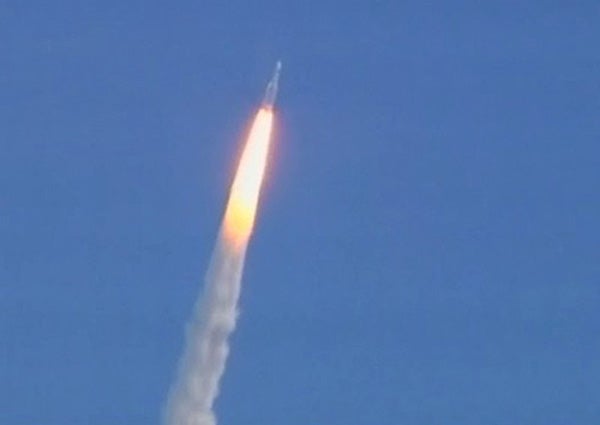Two of the most ambitious missions ever attempted to unveil the secrets of the darkest, coldest, and oldest parts of the universe got off to successful starts Thursday with the dual launch of the European Space Agency’s (ESA) Herschel and Planck missions on an Ariane 5 rocket from Europe’s Spaceport on French Guiana. Herschel is a far infrared space telescope, and Planck is a cosmic background mapper.
Herschel, equipped with the largest mirror ever launched into space, will observe a mostly uncharted part of the electromagnetic spectrum to study the birth of stars and galaxies as well as dust clouds and planet-forming disks around stars. In addition, it will be the most effective tool ever devised to look for the presence of water in remote parts of the universe.
Planck is designed to map tiny irregularities in fossil radiation left over from the very first light in the universe that was emitted shortly after the Big Bang. Planck will have enough sensitivity to reach the experimental limits of what can be observed, thus peering into the early universe and studying the elusive dark matter and dark energy that continue to puzzle the science community worldwide.
A Journey to L2
ESA lofted both of these highly sophisticated spacecraft into space atop an Ariane 5 ECA vehicle from Europe’s spaceport in Kourou, French Guiana, at 9:12 a.m. EST (13:12 UTC/GMT) Thursday, May 14, 2009. Almost 26 minutes later, and about 2 minutes from each other, they were released separately on an escape trajectory toward a virtual point in space, called L2, approximately 930,000 miles (1.5 million kilometers) from Earth in the opposite direction of the Sun.
Since the acquisition of the first radio signals from the two satellites at 11:49 a.m. EST (15:49 UTC/GMT) today, they have now come under the control of ESA’s European Space Operations Center (ESOC) in Darmstadt, Germany. Both appear to be in nominal condition on their way toward their final orbit around L2. Their first trajectory correction maneuvers are scheduled for May 15.
After about two months, the two satellites will begin their scientific observations from two separate orbits around L2, where the combined pull of the Earth and Sun creates a gravitational stability point. Once there, undisturbed by thermal and radiation interference caused by the Sun, Earth, or the Moon, Herschel will observe pre-selected celestial targets while Planck will perform a continuous survey of the overall sky.
“With Herschel, we can resume the pioneering work undertaken with ESA’s first Infrared Space Observatory (ISO) operating in the second half of the ’90s,” said David Southwood, ESA’s director of science and robotic exploration, “and we are building upon the experience gained to date by the worldwide scientific community in the field of infrared astronomy.”
“Planck is ESA’s first mission dedicated to the study of relic radiation from the Big Bang, designed to continue the marvelous work undertaken over the last 20 years by Russia’s Relikt and NASA’s COBE and WMAP satellites,” said Southwood. “With Planck, we are pushing the boundaries of our knowledge to the very limits of what can be observed according to theory.”
“This dual launch is the crowning of 20 years of hard work for the scientists who imagined these missions, the engineers who designed these satellites, the firms that built them, and the ESA staff who coordinated all these efforts,” said Jean-Jacques Dordain, ESA’s director general. “This marvelous work could never have been accomplished without the commitment of all of ESA’s member states, which have consistently ensured that space science remains the backbone of our activities.”
“Herschel and Planck are the most complex science satellites ever built in Europe,” said Dordain. An industrial team led by Thales Alenia Space France, comprised of more than 100 contractors from 15 countries in Europe and the United States, developed the two satellites.”
“Herschel and Planck will enable us to go far back in time, to the origins of our universe. It is only by better understanding our universe’s overall past that we can help to better define the future of our planet, not as a self-standing celestial body but as an integral part of the whole system,” Dordain concluded.










